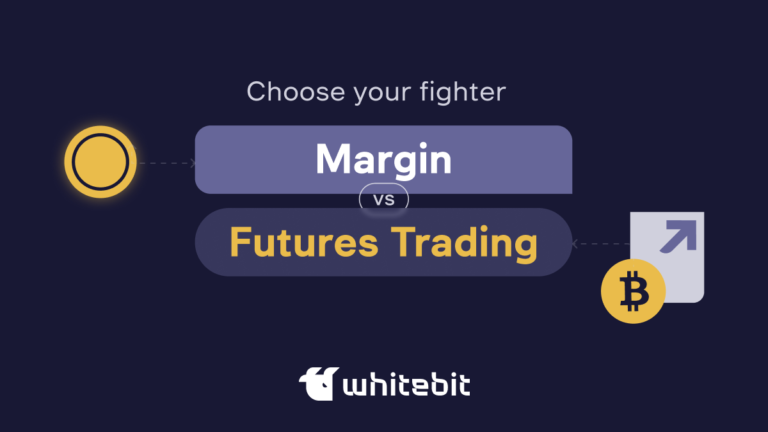What is the Wyckoff Method and How to Apply It in Crypto Trading?

Content
Understanding market dynamics is crucial in navigating the complexities of trading, and the Wyckoff method stands as a comprehensive guide. Initially designed for traditional markets, this method has seamlessly transitioned into cryptocurrency trading, offering valuable insights into market structure and turning points. Traders utilizing the Wyckoff Method on cryptocurrency exchanges, such as the WhiteBIT cryptocurrency exchange, gain a nuanced understanding of market cycles and institutional behavior, empowering them to make informed decisions in this dynamic landscape.
What is the Wyckoff Method?
The Wyckoff method, pioneered by Richard D. Wyckoff, stands as a holistic and sophisticated framework for market analysis and trading in cryptocurrencies and stocks. Rooted in the fundamental principles of supply and demand dynamics, this method seeks to unravel the intentions of influential market participants, including large traders and institutions. The Wyckoff pattern equips traders with invaluable insights into the fundamental structure of the market and empowers them to discern potential turning points.
Originally conceived for traditional financial markets, the Wyckoff theory has proven to be highly adaptable, finding significant relevance and application in the dynamic landscape of cryptocurrency trading. In essence, it serves as a compass for traders navigating the complexities of digital asset markets, offering a nuanced understanding of market dynamics that extends beyond conventional technical analysis.
A Five-Step Approach to the Market
The Wyckoff Method offers a powerful framework for traders seeking to navigate the complexities of crypto markets. Here’s a simple guide on how to apply the Wyckoff Method in your daily crypto trading:
Step 1. Crafting a profitable investment strategy involves evaluating the present market position and predicting future trends. This often entails utilizing trading charts and historical pricing data to conduct a comprehensive analysis of the market index.
Step 2. Aligning your crypto portfolio with prevailing market trends is crucial. For those aiming for long-term investments, astutely choosing a coin or token that demonstrates strength relative to others is essential.
Step 3. Opting for crypto projects that meet or exceed predefined objectives is prudent. Optimal choices typically involve assets in an accumulation phase, ensuring potential for growth or already surpassing minimum benchmarks.
Step 4. Identifying cryptocurrencies poised for movement is key. Prioritize assets by ranking them in your preferred order. Use trading charts, leverage technical analysis, and utilize other instruments aligned with your trading strategy to assess potential fluctuations in the asset’s price.
Step 5. Allowing ample time for your selected asset to yield favorable returns is advisable. Implement Stop-Losses and trail them until you ultimately close the current position.
Wyckoff Market Cycle
Wyckoff Accumulation
At the heart of the Wyckoff method lies the critical Accumulation phase, where large traders, represented by institutions or large traders, strategically accumulate Wyckoff stock assets at favorable prices. This phase operates discreetly, often concealed from the watchful eyes of retail traders. During Accumulation, the smart money quietly builds substantial positions, establishing a foundation for the subsequent market movements. This is typically visually represented as a Wyckoff Accumulation Schematic on charts.
Markup
With the conclusion of the Accumulation phase, the market seamlessly transitions into the Markup phase. This stage is characterized by a notable price uptrend driven by heightened demand. It represents a key element in the Wyckoff price cycle, marking the transition from accumulation to a pronounced upward movement. As the smart money begins to profit from their accumulated assets, the Markup phase unveils opportunities for traders to capitalize on the upward momentum. Understanding the dynamics of this phase is essential for discerning profitable entry and exit points within the evolving market landscape.
Wyckoff Distribution
The Distribution phase marks a strategic shift in the behavior of smart money. Having benefited from the Markup, these entities strategically begin to distribute their holdings to the broader public. This phase is opportunistic, taking full advantage of the rising prices witnessed during the Markup. Retail traders may find themselves drawn into the market at this moment, unaware of the impending shift.
Markdown
Following the Distribution phase, the market undergoes a significant transformation as it enters the Markdown phase. Prices begin to decline as smart money successfully concludes their distribution activities. This downward trajectory catches retail traders off guard, often leading to unexpected losses for those who fail to recognize the shift in market dynamics. The Markdown phase serves as a critical component of the Wyckoff logic, representing a period of consolidation and preparation for the subsequent Accumulation phase.
Accumulation Redux
The Wyckoff method’s cyclical nature becomes apparent as the Markdown phase gives way to a renewed Accumulation phase. This marks the beginning of a new cycle, with smart money once again positioning themselves strategically to accumulate assets at favorable prices. Understanding this iterative process is fundamental for traders seeking to align their strategies with the broader Wyckoff Cycle.
Core Principles of the Method: Wyckoff Laws
The Law of Supply and Demand
The cryptocurrency market’s price movements are driven by the fundamental principle of supply and demand. When there’s a higher demand than supply, indicating more people want to buy the cryptocurrency than sell it, prices rise. On the flip side, when demand is lower than supply, meaning more people are selling than buying, prices decline. A balanced level where demand matches supply results in price stability and low market volatility. Thus, the interaction of demand and supply determines the direction and dynamics of price changes in the cryptocurrency market.
The Law of Cause and Effect
The Wyckoff method extends its influence through the Law of Cause and Effect, asserting that significant price movements are not arbitrary but are, instead, the consequence of substantial underlying causes. In essence, this principle underscores the importance of delving beyond surface-level price action and chart patterns. Traders employing the Wyckoff method are encouraged to seek and identify the root causes driving market movements. Whether it be fundamental developments, economic shifts, or geopolitical events, understanding the catalysts behind price shifts enables traders to make informed decisions and anticipate market trends.
The Law of Effort versus Result
Effort versus Result is a cornerstone principle that accentuates the analysis of trading volume in relation to price movements. This law proposes that the strength or weakness of a trend can be gauged by evaluating the relationship between the effort exerted in terms of trading volume and the resultant price changes. High trading volume accompanying significant price movements signifies a strong and sustainable trend, while low volume during price fluctuations may indicate a potential weakening of the prevailing trend.
Accumulation Events and Phases
A profound understanding of specific terms and abbreviations related to the accumulation of the Wyckoff events and phases is paramount:
- Preliminary Support (PS): This marks the inception of the Wyckoff Accumulation pattern, representing a critical juncture where smart money begins quietly accumulating assets at favorable prices. It sets the foundation for subsequent movements within the market cycle;
- Selling Climax (SC): The Selling Climax is an event characterized by a significant and abrupt drop in prices. This event signals the strategic actions of smart money as they accumulate assets amid the chaos created by the sudden decline. It serves as a precursor to the subsequent Automatic Rally;
- Automatic Rally (AR): Following the Selling Climax, an Automatic Rally ensues, manifesting as a swift bounce in prices. This phase reflects the rebound effect orchestrated by smart money, capitalizing on the panic-driven market conditions during the Selling Climax;
- Secondary Test (ST): The Secondary Test is a stage that follows the Automatic Rally. It involves a reevaluation of the preceding low after the initial bounce. This phase allows smart money to assess the market’s resilience and the potential for the further accumulation of Wyckoff events.
Distribution Events and Phases
The Distribution phase emerges as a chapter where smart money orchestrates the strategic release of accumulated assets. Within this phase, specific events unfold, providing traders with insights into market dynamics.
Upthrust: Deceptive Breakouts
An Upthrust, a deceptive false breakout to the upside, is a pivotal event during the Distribution phase. Recognizing this maneuver allows traders to stay vigilant, understanding it as a strategic move by smart money before the impending markdown.
Preliminary Supply: Early Warning
The Preliminary Supply (PSY) signals the onset of the Distribution phase, indicating smart money’s initiation of strategic selling. Monitoring the PSY serves as an early warning for traders, preparing them for subsequent developments in this market phase.
Last Point of Supply: Culmination Marker
The Last Point of Supply (LPSY) marks the conclusion of the Distribution phase, signifying the final release of smart money’s holdings. Observing the LPSY provides traders with insights into the end of distribution, allowing strategic positioning for the upcoming market dynamics.
Applying the Wyckoff Method to Crypto Trading
Cryptocurrency markets have unique aspects, such as 24/7 trading, high volatility, and susceptibility to manipulation. Applying the Wyckoff phases to crypto assets involves adapting the method to these characteristics. Traders must consider the influence of major players, often referred to as the “Composite Man,” and understand how market cycles manifest in crypto prices.
Challenges and Limitations of Using The Wyckoff Trading Method
While the Wyckoff method provides a robust framework, it’s not without challenges. In volatile crypto markets, rapid price movements and sudden shifts in sentiment can make accurate analysis challenging. Traders should be aware of potential pitfalls, such as misinterpreting signals or underestimating the impact of external factors.
Supporting Tools and Indicators
To enhance the application of the Wyckoff method, traders can use various tools and indicators. These may include Wyckoff charts, traditional technical indicators, and specialized Wyckoff analytics. Additionally, understanding cryptocurrency exchange rates, utilizing cryptocurrency charts, and staying informed about crypto spot trading trends can provide valuable context.
Conclusion
The Wyckoff methods, with their focus on market dynamics and institutional behavior, offer a valuable framework for traders in both traditional and cryptocurrency markets, especially in the context of crypto spot trading. By understanding the principles, events, and phases outlined by Wyckoff, traders can gain insights into potential market movements. However, it’s nice to adapt the method to the unique characteristics of crypto trading, particularly in spot trading, and remain vigilant in the face of the challenges posed by this dynamic and rapidly evolving market.
FAQ
The Wyckoff method is used for market analysis and trading. It helps traders understand the intentions of large players (smart money) by focusing on supply and demand dynamics, aiding in the identification of potential market turning points.
The accuracy of the Wyckoff method depends on various factors, including market conditions and the skill of the trader. While it provides a robust framework for Wyckoff analysis, success relies on the trader's ability to interpret signals accurately and adapt the method to different market situations.
The Wyckoff method has been proven effective by many traders. Its success is attributed to its emphasis on understanding market psychology and institutional behavior. However, like any trading method, its effectiveness depends on the trader's skill, experience, and ability to apply the principles in diverse market conditions.
Wyckoff's distribution is a phase in the Wyckoff method where smart money strategically sells assets to the public, leading to a market top. It is characterized by the controlled release of holdings, often marked by specific events, price movements, and Distribution schematics.
Wyckoff Accumulation is a phase in the Wyckoff method where smart money quietly accumulates assets at favorable prices. It precedes an upward markup phase, and it is often visually represented on charts through Wyckoff schematics. A stable pricing environment characterizes this phase as smart money strategically builds their positions.












